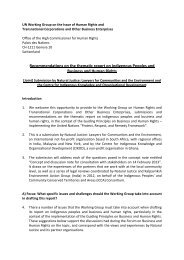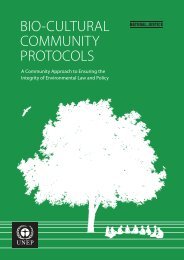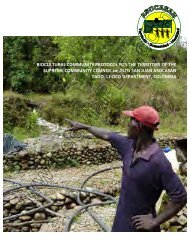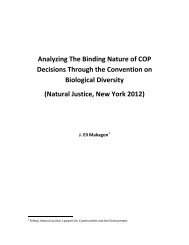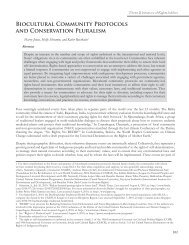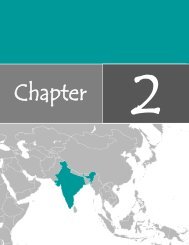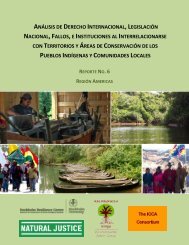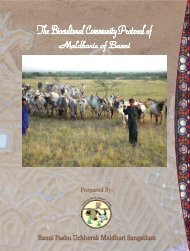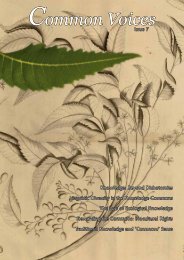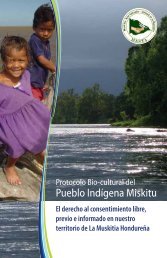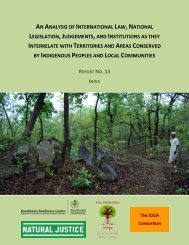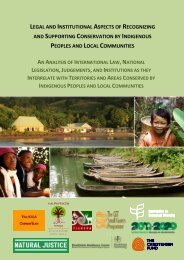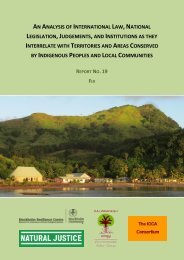Part III, Chapter 11.pdf - Natural Justice
Part III, Chapter 11.pdf - Natural Justice
Part III, Chapter 11.pdf - Natural Justice
- No tags were found...
Create successful ePaper yourself
Turn your PDF publications into a flip-book with our unique Google optimized e-Paper software.
PART<strong>III</strong>Analysis and Looking Ahead
<strong>Chapter</strong>11
207Reforming Rights to Support ResponsibilitiesHarry Jonas and Holly Jonas“1. IntroductionThe preceding chapters in <strong>Part</strong> II underscore the many forms of responsibility embodied andarticulated by the respective Indigenous peoples and local communities, including towards theirancestors and future generations, territories, and other integral elements of their cultures andspirituality. In <strong>Chapter</strong> 3, Oli et al. provide a succinct summary of one group of communities’views of localised responsibility for their territories in the Indian part of the Kailash SacredLandscape (KSL). They state that the communities “perceive the earth, forests surroundingvillages, biological diversity (including crop diversity), and festivals as existing in the realm of asacred trust inherited from their ancestors.” 1 The authors go on to say:Sacred values and religious practices have formed the basis of the attitudes andfeelings of local people towards nature conservation and fostered anenvironmental ethic that essentially considers human beings as a part of nature,which in itself is seen as a guardian or manifestation of the sacred. The regionthus has a cultural and sacred geography etched in the landscape. Local peopleconsider nature a power that plays a vital role as the benefactor of theirsustenance; in turn, people prescribe obligations towards nature in the form ofcustoms and the consequent values and attitudes.”The chapters also illustrate the wide range of “complex challenges and confusing messages” 2encountered by Indigenous peoples and local communities living between development,conservation and the law. 3 On the one hand, they are considered to be “guardians ofbiodiversity” 4 whose ways of life are internationally recognised as “relevant for theconservation and sustainable use of biological diversity”. 5 On the other hand, and among otherthings, they are accused of standing in the way of development and being “selfish” 6 in the faceof larger societal ‘needs’ for the resources found on their lands. Vaz and Agama underscore this1 G. B. Pant Institute of Himalayan Environment and Development, 2011. Traditional Knowledge System inManaging Forest Resources in KSL-India. ICIMOD: Kathmandu, Nepal.2 Vaz, J., and A. Agama, <strong>Chapter</strong> 10.3 See also: Morel, C., 2010. “Conservation and Indigenous Peoples’ Rights: Must one necessarily come at theexpense of the other?” pages 174-181 in Shrumm, H. (ed), Policy Matters 17: Exploring the Right to Diversity inConservation Law, Policy and Practice. IUCN-CEESP: Malaysia.4 Food and Agriculture Organization of the United Nations (FAO), 2009. Livestock Keepers: Guardians ofBiodiversity. Animal Production and Health Paper 167. FAO: Rome. Quoted by Köhler-Rollefson, I., <strong>Chapter</strong> 7.5 Secretariat of the Convention on Biological Diversity (CBD) (no date). “Article 8(j) – Traditional Knowledge,Innovations and Practices”. Last accessed 1 June, 2013, at: http://www.cbd.int/traditional/.6 Vaz and Agama, <strong>Chapter</strong> 10.
208point in <strong>Chapter</strong> 10, stating that “… traditional ways of life and customary uses of naturalresources continue to be perceived [by government agencies and others] as backward and lessproductive or, at best, as nostalgic artefacts of a bygone era that should be replaced by themodernising influence of development.” 7 The chapters also highlight how Indigenous peoplesand local communities are compelled to navigate the space between such dichotomies andengage with a myriad of legal frameworks and institutions in order to secure their right to selfdetermination,8 both by active resistance as well as positive engagement.In this context, this chapter draws on the preceding contributions as well as the ICCARecognition Study 9 and Legal Review 10 mentioned in <strong>Chapter</strong> 1 to explore the ways in whichlegal processes, laws, and institutions are impacting communities’ abilities to self-determinetheir futures in ways that accord with their understandings of respective rights andresponsibilities.Sections 2-6 in this chapter set out how the formation and nature of laws and the judicialsystem act as systemic barriers to local social and ecological justice, and how the limited legalcapacities of many communities can exacerbate this complex of factors. 11 With reference to theRaika community in Rajasthan, India, Section 7 illustrates the myriad laws, institutions, andscales with which Indigenous peoples and local communities engage to protect and maintainthe social and ecological integrity of their territories and areas. Section 8 highlights a number ofpositive developments and gains that are being made in different jurisdictions in spite of themany barriers.Looking ahead in this part of the book, <strong>Chapter</strong> 12 suggests necessary and urgent reformsrequired to protect Indigenous peoples and local communities against the worst excesses ofdevelopment and conservation, while at the same time supporting their proactive responses toever-changing circumstances. <strong>Chapter</strong> 13 challenges legal practitioners to build on this book’sanalysis to consider new and innovative approaches to supporting Indigenous peoples and localcommunities to uphold the full extent of their right to self-determination, including by recourseto a landscape approach to legal empowerment.7 Vaz and Agama, <strong>Chapter</strong> 10.8 Coulter, R., 2010. “The Law of Self-Determination and the United Nations Declaration on the Rights of IndigenousPeoples.” UCLA Journal of International Law and Foreign Affairs, 15(1): 1-16.9 Kothari, A., with C. Corrigan, H. Jonas, A. Neumann, and H. Shrumm (eds.), 2012. Recognising and SupportingTerritories and Areas Conserved By Indigenous Peoples and Local Communities: Global Overview and National CaseStudies. Secretariat of the CBD, ICCA Consortium, Kalpavriksh, and <strong>Natural</strong> <strong>Justice</strong>: Montreal, Canada. TechnicalSeries No. 64. Last accessed 4 March, 2013, at: http://www.cbd.int/doc/publications/cbd-ts-64-en.pdf.10 Jonas, H., E. Makagon, and H. Shrumm, 2012. Legal and Institutional Aspects of Recognizing and SupportingConservation by Indigenous Peoples and Local Communities: An Analysis of International Law, National Legislation,Judgements and Institutions as they Interrelate with Territories and Areas Conserved by Indigenous Peoples andLocal Communities. <strong>Natural</strong> <strong>Justice</strong> and Kalpavriksh: Bangalore and Pune. Last accessed 4 March, 2013, at:http://naturaljustice.org/library/our-publications/legal-research-resources/icca-legal-reviews.11 Notably, non-legal recognition and support of ICCAs remains absent, weak, or inappropriate. For more discussionabout non-legal support for ICCAs, see Kothari et al., 2012.
2092. The Discriminatory Nature of the Development, Implementationand Enforcement of LawsThe preceding chapters clearly illustrate that, in addition to the substantive provisionsthemselves, the very processes through which laws are developed, implemented and enforceddiscriminate structurally and consistently against Indigenous peoples and local communities ina number of ways. First, peoples and communities are seldom meaningfully involved in thedrafting of legislation or the decision-making processes that will impact them. This ishighlighted in the Indonesian context, for example, where the property rights of Indigenouspeoples over traditional lands were not appropriately taken into account in the formulation ofthe REDD+ Regulation. 12 Similarly, neither the Raika in India nor the Sonahas in Nepal wereinvolved in the decision-making procedures that led to their exclusion from the KumbalgarhWildlife Sanctuary 13 and Bardia National Park, 14 respectively.Second, laws that support the rights of Indigenous peoples and local communities on paper canbe severely undermined where state agencies, either wilfully or by neglect, inadequatelyimplement them or implement them in ways that defeat the laws’ original intent. Dash andKothari speak to this point in great detail in their analysis of the Forest Rights Act in India in<strong>Chapter</strong> 8. They conclude that despite the Act’s “revolutionary potential”, it lacks fullimplementation due to a number of interlinked factors, “with the dominant political systemserving as a major cause”.The same chapter by Dash and Kothari also provides useful insight into a third factor. Asillustrated by the efforts of the Indigenous Dongria Kondhs to save Niyamgiri, laws that arefavourable to Indigenous peoples and local communities are often disregarded where they arein conflict with laws such as those facilitating industrial resource extraction or production.Connected to this is the fact that Indigenous peoples’ rights are often weakened or madesubject to other rights and interests (for example, vis-à-vis property or corporations),something that does not happen to other rights or legal entities. An example from the LegalReview is provided by the otherwise progressive Indigenous Peoples’ Rights Act of thePhilippines, which is overridden by the Mining Act frequently and with disastrous outcomes. 15Figure 1 (following page): Anti-Bhopalpatnam dam rally in Hemalkasa, Maharashtra (India) © Ashish Kothari12 Anderson, P., and M. Colchester, <strong>Chapter</strong> 9.13 Köhler-Rollefson, I., <strong>Chapter</strong> 7.14 Jana, S., <strong>Chapter</strong> 5.15 The Philippine Mining Act (1995) is shown to be in direct opposition to Indigenous peoples’ and localcommunities’ interests. Pedragosa, S., 2012. An Analysis of International Law, National Legislation, Judgements,and Institutions as they Interrelate with Territories and Areas Conserved by Indigenous Peoples and LocalCommunities: Report No. 16: The Philippines. <strong>Natural</strong> <strong>Justice</strong> and Kalpavriksh: Bangalore and Pune.
210
211Fourth, laws define the nature of geographical spaces and the activities permissible withinthose spaces. This point has been greatly developed by legal geographers 16 and is seen veryclearly in the preceding chapters. Designating a protected area, for example, immediatelyredefines, among other things, the nature of the area and persons legally permitted to governand/or manage the area and for what uses or outcomes. Legally, the nature of lands andresources traditionally used by communities, such as those described in the chapters by Jana,Köhler-Rollefson, and Vaz and Agama, are radically altered upon designation as protectedareas. As Jana states in <strong>Chapter</strong> 5, “a clearly demarcated bio-physical space … is constructedand further produced as areas of ecological significance and sites of critical biodiversity to beprotected from human influence.” The immediate legal effect of the decision to create theBardia National Park was the criminalisation of communities’ traditional settlements, ancientmigration routes, and customary uses of natural resources. 17Stevens highlights another element of this issue in <strong>Chapter</strong> 4 on ICCAs in Nepal by describingthe governmental backlash against a declaration by Sherpa leaders affirming their responsibilityfor Khumbu and declaring it to be an ICCA. While it seems that erroneous reporting andgovernmental-level misunderstanding may have contributed to what could be considered to bean overreaction, at its core, the case illustrates the vigour with which governments defendedtheir monopoly over the demarcation of land, including over the values that can be attributedto certain areas. In that instance, the government showed no willingness to consideroverlapping designations or community governance of Khumbu, instead calling on the Sherpaleaders to formally apologise for the ‘illegal’ declaration over what they claimed to be theircustomary territory.The fifth factor is a corollary of the fourth. Just as laws describe the legal nature of geographicalspace, they also create legal and institutional spaces. Yet these legal spaces are ofteninaccessible to Indigenous peoples and local communities. 18 Anderson and Colchester providean example of this dynamic in <strong>Chapter</strong> 9. Through legal means, the carbon-sequesteringpotential of the forest of Ulu Masen in Indonesia has been monetised, and the resulting carboncredits are transferable. They describe how Carbon Conservation subsequently sold assets inthe Ulu Masen project to East Asia Minerals Corporation, a Canadian mining company.Highlighting the resulting injustice, Vanda Mutia Dewi, coordinator of the national NGOGreenomics Indonesia, states the following of the deal:16 See, for example: Butler, C., 2009. “Critical Legal Studies and the Politics of Space.” Social Legal StudiesSeptember, 18(3): 313-332; Blomley, N., D. Delaney, and R. Ford, 2001. The Legal Geographies Reader. Blackwell:Oxford.17 In this context, Brendan Tobin’s play on words is particularly apt: “the law giveth and the law taketh away”.Tobin, B., 2010. “The Law Giveth and the Law Taketh Away: The Case for Recognition of Customary Law in Accessand Benefit Sharing and Traditional Resource Governance”, pages 16-25 in Shrumm, H. (ed), Policy Matters 17:Exploring the Right to Diversity in Conservation Law, Policy and Practice. IUCN-CEESP: Malaysia.18 Like Jana in <strong>Chapter</strong> 5, use of the word ‘space’ here is in reference to the multiplicity, complexity, and dynamismof the meaning and politics of space as theorised by Henry Lefebvre, inter alia, and not limited to the material andphysical sense of the word. See Lefebvre, H., 1991. The Production of Space. Blackwell: Oxford, United Kingdom,and Cambridge, USA.
212“On the one hand, East Asia Minerals Corporation has a commercial interest ingold mining in Aceh’s forests, the Miwah project, while on the other hand,Carbon Conservation has been granted exclusive rights by the Aceh Governor tosell and market carbon credits related to more than 700,000 hectares of Acehforest located in the Ulu Masen forest block. Why are Aceh’s forests being usedas an asset by Carbon Conservation to obtain funds from a share transaction withEast Asia Minerals Corporation? This clearly involves a conflict of interest. CarbonConservation has misused the agreement it entered into with the Government of”Aceh. This share transaction must be rejected outright. 19While the nature of the owner of these assets may have great impacts on the communities ofUlu Masen, the commercial ‘space’ within which these deals take place is inaccessible tocommunity members who may subscribe to Mutia Dewi’s view and want to challenge thetransaction. This illustrates how law creates intangible yet very real spaces that are themselvesembedded in broader political and economic claims. Community access to these spaces can behighly restricted, constituting a denial of procedural and substantive justice.3. The Fragmentary Nature of the LawThere is a growing body of literature underscoring the need for a landscape approach toconservation 20 and much greater focus on social and ecological connectivity. 21 However, theway the law is developed often denies this reality because laws and institutional arrangementsseldom reflect the social-ecological linkages across landscapes and seascapes and betweenecosystems. Thus, even where laws are prima facie supportive, they can still be inherentlychallenging to Indigenous peoples and local communities intent on using them to protect theirways of life. These challenges are manifest in at least three ways.First, laws have a tendency to compartmentalise otherwise interdependent aspects ofbiological and cultural diversity. While communities manage integrated territories and areas,19 Greenomics Indonesia Press Release, 4 May, 2011. “Aceh’s Forests Greasing Works of Australian CarbonCompany’s Share Dealings”. Last accessed 31 March, 2012, at: http://www.redd-monitor.org/wordpress/wpcontent/uploads/2011/05/11-05-04_Greenomics.pdf.20 See, for example: Brown, J., and A. Kothari, 2011. “Traditional Agricultural Landscapes and CommunityConserved Areas: An Overview.” Management of Environmental Quality: An International Journal, 22(2): 139-153;Brown, J., N. Mitchell, and M. Beresford (eds.), 2005. The Protected Landscape Approach. Linking Nature, Cultureand Community. IUCN: Gland, Switzerland, and Cambridge; Amend, T., J. Brown, A. Kothari, A. Phillips, and S.Stolton (eds.), 2008. Protected Landscapes and Agrobiodiversity Values. Volume 1 in the Values of ProtectedLandscapes and Seascapes Series. IUCN and GTZ: Gland, Switzerland; Mallarach, J. M. (ed.), 2008. ProtectedLandscapes and Cultural and Spiritual Values. Volume 2 in the Values of Protected Landscapes and SeascapesSeries. IUCN: Gland, Switzerland; Dudley, N., and S. Stolton (eds.), 2012. Protected Landscapes and WildBiodiversity. Volume 3 in the Values of Protected Landscapes and Seascapes Series. IUCN: Gland, Switzerland.21 Crooks, K., and M. Sanjayan (eds.), 2006. Connectivity Conservation. Cambridge University Press: UnitedKingdom; Lausche, B., 2012. The Legal Aspects of Connectivity Conservation: A Concept Paper (Draft 8 August,2012). IUCN: Gland, Switzerland.
213sometimes spanning entire landscapes and seascapes, states tend to see humans and nature inisolation from each other as well as view individual resources through a narrow lens, drawinglegislative borders around (for example) land, natural resources, and traditional knowledge.This often leads to the exclusion of peoples and communities from areas in which they havelived for generations as well as policies and plans that privilege a singular view of thelandscape’s or seascape’s value and purpose, for example, for ‘agricultural use’ or‘conservation’. In <strong>Chapter</strong> 7, Köhler-Rollefson underscores this point in India by illustrating howthe Central Empowered Committee’s decision to exclude the Raika from the KumbalgarhWildlife Sanctuary was taken without fully evaluating its social and ecological ramifications. Itsdecision failed to consider the nuanced interconnections between the Raika’s way of life, theirIndigenous livestock breeds, and the species and ecosystem dynamics of the Kumbalgarh forestnow contained within the Sanctuary. As Köhler-Rollefson points out, in this sense, the Raikaconsider themselves integral to the broader ecosystem and fulfil a range of important roles thatbenefit the forest. In addition to excluding the very people and animals who helped create andmaintain the Kumbalgarh forest, the Committee’s decision has also seriously affected thelivelihoods of the Raika, further disrupting social and cultural systems, and endangering thesurvival of the climate-resilient animal genetic resources of which they are “creators andguardians”. 22Second, the fragmentary nature of the law is compounded by the fact that it is implemented bymultiple state agencies, each of which focuses on a particular issue such as biodiversity, forests,agriculture, or Indigenous knowledge systems. 23 At the same time, sectoral approaches tend tomandate the overexploitation of particular resources, often by external actors and for shorttermeconomic gains. In this light, new and emerging financial and market-based incentiveschemes such as access and benefit sharing and REDD remain heavily contested. As pointed outby Kohli in <strong>Chapter</strong> 2 and by Anderson and Colchester in <strong>Chapter</strong> 9, some Indigenous peoplesand local communities have legitimate concerns that these emerging legal frameworks willincrease their marginalisation, in addition to further consolidating the governmental andprivate sector view that natural resources and ecosystem processes (or ‘services’) are merelytradable commodities. 24 The result is that communities’ lives are disaggregated in law andpolicy, forcing their claims to self-determination into issue-specific sites of struggle. Thefollowing illustration shows how the legal landscape fragments social-ecological landscapes andtangible and intangible values therein.Figure 2 (following page): Illustrative depiction of the legal landscape © Priya Kuriyan and <strong>Natural</strong> <strong>Justice</strong>22 Köhler-Rollefson, <strong>Chapter</strong> 7.23 In some countries, for example, genetic resources are dealt with by separate departments from traditionalknowledge.24 Ituarte-Lima, C., and S. Subramanian, 2011. Environment-related Property Laws: A Means to Achieve Equity ofInequity? UNU-IAS Working Paper 164. UNU-IAS: Yokohama, Japan.
214
215Third, state laws often conflict with the customary laws that govern communities’ stewardshipof territories and natural resources therein. 25 For example, the understanding of ‘property’under positive or state law is based on the private rights of a person (human or corporate) toappropriate and alienate physical and intellectual property. In contrast, as detailed by all of theauthors to a greater or lesser extent, communities’ property systems tend to emphasiserelational and collective values of resources. 26 Elsewhere, Koschade and Peters make thedistinction between legal jurisdiction and Indigenous notions of ethical responsibility. 27 In thiscontext, many Indigenous peoples’ and local communities do not see themselves as mere‘owners’ of land in a legal sense, but as stewards or custodians of the land, including its culturaland spiritual values. 28 A legal system that denies a plurality of ethics has direct impacts oncommunities’ lives and the environments upon which they depend, for example, byundermining the cultural practices and institutions that underpin stewardship of territories andecosystems.Many of the same tendencies of national or sub-national laws and institutions are replicated atthe international level. Notwithstanding the advances in international law noted in theInternational Law and Jurisprudence Report, 29 the rights gains have been achieved in manycases against determined counterforces. 30 Indigenous peoples and local communities struggleto be fully involved in the meetings, as evidenced in the meetings of the World Intellectual25 Cotula, L., and P. Mathieu (eds.), 2008. Legal Empowerment in Practice, Using Legal Tools to Secure Land Rightsin Africa. IIED: London. Also see: Cuskelly, K., 2011. Customs and Constitutions: State Recognition of Customary LawAround the World. IUCN: Bangkok, Thailand; and Rose, G., and J. Dahl (eds.), 2010. “Development and CustomaryLaw” (special issue). Indigenous Affairs, 1(2).26 Tobin, B., and E. Taylor, 2009. “Across the Great Divide: A Case Study of Complementarity and Conflict BetweenCustomary Law and TK Protection Legislation in Peru”. Initiative for the Prevention of Biopiracy, IV(11): 1-68. Suchsystems have been described as “...commonly characterized by collective ownership (where the community ownsa resource, but individuals may acquire superior rights to or responsibilities for collective property), and communalownership (where the property is indivisibly owned by the community).” Also see Bavikatte, K. (forthcoming).Stewarding the Earth: Rethinking Property and the Emergence of Biocultural Rights. Oxford University Press: Delhi.27 Koschade, B., and E. J. Peters, 2006. “Algonquin Notions of Jurisdiction: Inserting Indigenous Voices into LegalSpaces”. Geografiska Annaler, 88(3): 299-310. In their article, the authors state the following about Algonquincommunity members vis-à-vis the management of the Tay watershed:They wanted to provide direction and guidance on the management of the Tay watershed, which wasintertwined in the concept of responsibility, jurisdiction and knowledge. The structure of the Algonquinknowledge of the land came from sustained experience, the survival of many generations, and thepersonal connection that each individual made to place. In other words, Algonquin jurisdiction was themanifestation of that knowledge which was the responsibility to continue the practices of the Algonquinpeople in relation to their environment, to fulfil the duty given to them by the Creator to care for all theother living beings in nature.28 Also see Bavikatte, K., forthcoming. Stewarding the Earth: Rethinking Property and the Emergence of BioculturalRights. Oxford University Press: New Delhi.29 Jonas, H., J. E. Makagon, S. Booker, and H. Shrumm, 2012. An Analysis of International Law, National Legislation,Judgements, and Institutions as they Interrelate with Territories and Areas Conserved by Indigenous Peoples andLocal Communities: Report No. 1: International Law and Jurisprudence. <strong>Natural</strong> <strong>Justice</strong> and Kalpavriksh: Bangaloreand Pune. Last accessed 4 March, 2013, at: http://naturaljustice.org/wpcontent/uploads/pdf/ICCALegalReviewINTERNATIONALLAWANDJURISPRUDENCE.pdf.30 Dahl, J., 2012. The Indigenous Space and Marginalized Peoples in the United Nations. McMillan: United Kingdom.
217ecological systems. The implementation of such laws compounds these challenges by requiringcommunities to engage with disparate stakeholders 36 according to a variety of disconnectedregulatory frameworks, many of which may conflict with their customary laws, institutions, anddecision-making processes.4. Inappropriate LegislationAcross jurisdictions, similar types of laws are often framed in ways that are biased againstIndigenous peoples and local communities, further hindering their ability to retain the integrityof their territories and areas. Six tendencies emerge in the contributions to this book that arecorroborated by the aforementioned Recognition Study and Legal Review, among others.First, respect for human rights is severely lacking. Perpetuating the injustices caused by theDoctrine of Discovery, many countries continue to ignore or undermine the most importantprinciples, rights, and obligations enshrined in ILO Convention 169, UNDRIP, and otherfundamental international human rights covenants and declarations, and have failed to enactnew legislation or adapt existing frameworks to ensure coherence and compliance at thenational and sub-national levels. As detailed in the preceding chapters, exploitation of naturalresources and the imposition or overlapping of state protected areas on customary territoriesand areas still take place without the involvement and free, prior and informed consent of therespective peoples and communities. More broadly, traditional authorities and otherappropriate representatives of Indigenous peoples and local communities have extremelylimited opportunities to participate in national decision-making processes. Of the mechanismsthat do exist, many fail to ensure genuine and meaningful processes of participation,particularly of Indigenous women. Moreover, legitimate struggles of leaders and communitymembers against the destruction of their territories, resources, and cultures are routinelycriminalised and faced with militarisation, extra-judicial killings, kidnappings, and unlawfuldetentions. The denial of Indigenous peoples’ and local communities’ substantive andprocedural human rights through states’ actions and inactions – often in cooperation withcorporations or organisations driving the interventions – fuels conflict, degrades ecosystems,and significantly undermines community cohesion and solidarity. The recent abduction of Laosactivist Sombath Somphone is just one example of the dangers faced by advocates of a fairerworld. 37Second, there is a lack of recognition of customary laws and traditional authorities, institutions,and decision-making processes. 38 The multifaceted roles of women are often overlooked as36 Examples include government agencies and officials, conservation and development NGOs, private sectorcompanies, the media, and researchers.37 See WordPress blog dedicated to Sombath Somphone. Last accessed 30 May, 2013, at: http://sombath.org/.38Colchester, M., and S. Chao (eds.), 2011. Divers Paths To <strong>Justice</strong>: Legal pluralism and the rights of indigenouspeoples in Southeast Asia. Forest Peoples Programme and Asia Indigenous Peoples Pact (AIPP): Chiang Mai,Thailand. In that volume, see: Shimray, G., “Legal Pluralism in South East Asia, Insights from Nagaland”, pages 8-16.
218well. Where these are not recognised, culturally embedded systems of caring for territories andresources and engaging with others are undermined, often leading to deterioration oftraditional languages and sophisticated systems of knowledge and practice. Anderson andColchester underscore this point in their chapter on REDD+ in Indonesia. They quote from aninterview with Pak Nas, the chairman of the association of Mukims (traditional institutions forinter-village decision-making) of the Aceh Besar District, speaking about his perspectives on theemergence of REDD+. He states:“For a plan to be developed on benefit sharing and REDD+, it must involve thewhole community. It isn’t right for the government to make the plan itself or forthe government to just ask me as a community leader to make such a plan.Meetings must be held in each affected village, in each Mukim, and at the districtlevel to discuss and decide on systems for benefit sharing and for managing ourforests. Our customary leaders and customary institutions still exist, but thegovernment does not acknowledge them as legitimate bodies. We are open tohaving this discussion with the government on REDD+ plans, but want the”government to respect our institutions and customary rights.Instead, peoples and communities are often required to establish institutions that accord withthe dominant national paradigm in order for their authorities to be recognised asrepresentatives. This violates a number of international human rights instruments that requirerecognition of Indigenous peoples’ and local communities’ self-defined governance structures,and can lead to outsiders ‘consulting’ with and obtaining the agreement of imposed structuresinstead of the legitimate traditional authorities. Community cohesion and internal capacity torespond effectively to external threats are further undermined. In the same chapter byAnderson and Colchester, Pak Nas also states:“Our system of village and natural resource management was severely weakenedby the 1979 national law on local government. This was during the Soehartoregime, when the government imposed its system of village administration ontous. As our traditional rules and institutions for managing our resources were nolonger respected, this meant that outsiders could come and exploit our forestsand develop agriculture on our lands and we were unable to stop them.Traditionally, any outsider wishing to hunt or take wood or rattan from ourforests or to clear an area for agriculture would have to obtain permission fromthe village and Mukim leaders. However, our right to control our resources is nownot respected by the government or by outsiders. We have become like tigers”without teeth, watching as our forests are exploited without our agreement.Third, the chapters underscore the centrality of land to communities and the widespreadinadequate recognition of customary land rights and contemporary human rights, particularlyAlso see: Sheleef, L., 2000. The Future of Tradition: Customary Law, Common Law and Legal Pluralism. Frank Cass:London, England, and Portland, Oregon.
219those of women. Although there are ongoing land tenure, governance, resource rights, andother major reforms in Asia (such as the Forest Rights Act in India and the proposed NationalLand Use Act in the Philippines) to address historical injustices, 39 many of these programmeshave not placed sufficient emphasis on customary systems of tenure, stewardship, ortrusteeship. Additionally, women often suffer from lacking formal rights to land tenure andcustomary systems of land and property distribution and inheritance. 40 Common propertyresources such as forests and rangelands remain particularly vulnerable as they are usuallyconsidered unoccupied, unregistered, and thus available for allocation by the state toindividuals or corporations. This situation is a fundamental source of insecurity and potentialand actual dispossession.Insecure land rights mean that Indigenous peoples and local communities are unable to legallyenforce their customary ownership, rules, and control, particularly when the government issuesexploitative concessions and other permits in their territories. It also hinders communities’abilities to make long-term plans in accordance with their own visions and aspirations,compounding legal uncertainty with further marginalisation. The examples of the Raika inRajasthan and Sonahas in Nepal underscore the precarious position of communities caughtbetween development, which they are seen to be opposing, and conservation, which they areaccused of confounding. The surge in large-scale land acquisition in Asia is rapidly intensifyingpressure on the traditional territories of pastoralists, small-scale and subsistence farmers,hunter-gatherers, forest-, river- and coast-dependent communities, and others in rural areas. 41In this context, we suggest that the appropriate reform and recognition of land rights (withparticular emphasis on collective or communal rights), perhaps above all others, will determinethe opportunities and scope for Indigenous peoples and local communities to secure theirterritories and areas and contribute effectively to conservation and sustainable livelihoods.Fourth, in many countries in Asia, laws relating to natural resources and the environment makeno special provision for Indigenous peoples or local communities. As noted above in the contextof the law’s general tendencies, and as per the chapters about Sonahas in Nepal (5), livestockkeepers in South Asia (7), and Dusun communities in Malaysia (10), the law in this contexteffectively criminalises aspects of local livelihoods and customary resource use practices. Forexample, there is a special provision for allocating fishing permits to Sonahas, but it is based onthe absolute discretion of the park authorities. There is also no domestic law to secure goldpanning rights in the rivers. In this context, Sonahas are routinely denied their right to alivelihood via fishing and/or gold panning.39 Asian NGO Coalition for Agrarian Reform and Rural Development, 2012a. CSO Land Reform Monitoring in Asia.ANGOC: Quezon City, the Philippines; Asian NGO Coalition for Agrarian Reform and Rural Development, 2012b.Securing the Right to Land in Asia: An Overview of Access to Land in Asia. ANGOC: Quezon City, the Philippines.40 AIPP, 2013. Indigenous Women in Southeast Asia: Challenges in their access to justice. AIPP Briefing Paper:Chiang Mai, Thailand; AIPP, 2012. Violence, Customary Law and Indigenous Women’s Rights in Asia. AIPP BriefingPaper: Chiang Mai, Thailand.41 See, for example: Chao, S., and M. Colchester (eds.), 2012. Human Rights and Agribusiness: Plural legalapproaches to conflict resolution, institutional strengthening and legal reform. Forest Peoples Programme andSawitWatch: United Kingdom and Indonesia.
220Figure 3: Many communities have customary systems for managing freshwater fisheries such as tagal in UluPapar, Sabah, Malaysia. © Rabani AyubFifth, protected areas laws are falling behind international rights and standards. There havebeen important advances in international protected area law and policy over the past ten years,most notably, the Convention on Biological Diversity (CBD) Programme of Work on ProtectedAreas. 42 However, most governments are struggling to enshrine these international standardswithin national protected area laws and policies. Some countries boast successful examples ofshared governance and co-management with Indigenous peoples and local communities or ofrecognition of local governance systems. 43 However, as illustrated in the chapters by Stevens(4), Jana (5), Köhler-Rollefson (7), Dash and Kothari (8), and Vaz and Agama (10), theestablishment, expansion, governance, and management of state and private protected areasoften conflict or overlap with the customary territories, areas, and practices of Indigenouspeoples and local communities. As Stevens sums up in unequivocal terms in <strong>Chapter</strong> 4:“Protected areas have often been expressions of colonialism and internalcolonialism, a powerful means of extending state authority or ‘territorialisation’over Indigenous peoples and their homelands. 44 As a result, state-declared and -governed protected areas have often violated human rights and the42 Element 2 on governance, participation, equity, and benefit sharing is particularly relevant. Secretariat of theCBD (no date). “Protected Areas”. Last accessed 20 April, 2013, at: https://www.cbd.int/protected/.43 In Asia-Pacific, Australia’s Indigenous Protected Areas programme is a laudable example. See Smyth, D., and H.Jaireth, 2012. An Analysis of International Law, National Legislation, Judgements, and Institutions as theyInterrelate with Territories and Areas Conserved by Indigenous Peoples and Local Communities: Report No. 18:Australia. <strong>Natural</strong> <strong>Justice</strong> and Kalpavriksh: Bangalore and Pune.44 Vandergeest, P., and W. L. Peluso, 1995. “Territorialization and state power in Thailand.” Theory and Society,24(3): 385-426; Nietschmann, B., 1994. “The fourth world: nations versus states,” pages 225-242 in Demko, G. J.,and W. B. Wood (eds.), Reordering the World: Geopolitical Perspectives on the 21st Century. Westview Press:Boulder; Scott, J. C., 1998. Seeing Like a State: How Certain Schemes to Improve the Human Condition Have Failed.Yale University Press: New Haven.
221internationally affirmed rights of Indigenous peoples, provoking conflicts oversovereignty, territory, natural resources, self-governance, self-determination,culture, values, livelihoods, and appropriate goals and means of development”and conservation.Moreover, few countries’ protected area frameworks recognise conservation efforts byIndigenous peoples or local communities or allow for full devolution of governance andmanagement of existing protected areas. In some that do, there is often an inappropriateimposition of top-down designations, institutional arrangements, or conservation requirementsin order to fit them into existing state protected area frameworks. This tendency is underminingthe diversity of existing and potential governance arrangements and is a significant risk toIndigenous peoples’ and local communities’ rights, ways of life, and the integrity andconnectivity of broader social-ecological systems. 45In formal protected areas that overlap with or subsume ICCAs, particularly those governed andmanaged by the state, Indigenous peoples and local communities generally bear adisproportionate amount of the costs and enjoy relatively few benefits other than menialemployment in tourism facilities or as guides or rangers. The establishment or expansion ofsuch protected areas is often a point of conflict, particularly when the customary use of naturalresources is prohibited and traditional knowledge systems are ignored. As illustrated by theabovementioned chapters that address protected areas, this atmosphere of legal uncertaintyand often harsh enforcement of top-down rules undermines customary systems ofstewardship, governance, and management. The subsequent deterioration of traditionalknowledge and customary laws, coupled with pressures from growing populations andmigrants, among others, make these areas prone to social tension and unsustainable use ofresources. 46Sixth, very few countries provide Indigenous peoples any rights over their sub-soil resources; inthose that do, the rights are muted. 47 As previously discussed, where laws regulating access tonatural resources (including sub-soil resources) are prejudicial to Indigenous peoples and localcommunities, laws that otherwise support their rights to retain the integrity of their territories45 On the benefits of local governance, see: Molnar, A., M. France, L. Purdy, and J. Karver, 2011. Community-basedForest Management: The Extent and Potential Scope of Community and Smallholder Forest Management andEnterprises. Rights and Resources Initiative: Washington, D.C.; Horwich, R., and J. Lyon, 2007. “CommunityConservation, Practitioners’ Answers to Critics.” Oryx, 41(3): 376-385. Persha, L., A. Agrawal, and A. Chhatre, 2011.“Social and Ecological Synergy: Local Rulemaking, Forest Livelihoods and Biodiversity Conservation.” Science, 331:1606-1608.46 Wittemyer, G., P. Elsen, W. T. Bean, A. Coleman, O. Burton, J. S. Brashares, 2008. “Accelerated HumanPopulation Growth at Protected Area Edges”. Science, 321: 123-126; West, P., and D. Brockington, 2006. “AnAnthropological Perspective on Some Unexpected Consequences of Protected Areas”. Conservation Biology, 20(3):609-616.47 See, for example, the Canadian country study from the Legal Review: Wilson, P., L. McDermott, N. Johnston, andM. Hamilton, 2012. An Analysis of International Law, National Legislation, Judgements, and Institutions as theyInterrelate with Territories and Areas Conserved by Indigenous Peoples and Local Communities: Report No. 8:Canada. <strong>Natural</strong> <strong>Justice</strong> and Kalpavriksh: Bangalore and Pune.
222and areas are significantly disabled. This is particularly evident in the context of laws relating tomining that are privileged by state agencies over the rights of peoples and communities. 485. Access to <strong>Justice</strong>A growing body of jurisprudence emerging from regional, national, and sub-national courtssupports the rights of Indigenous peoples and local communities, even when formal recognitionunder state law is lacking. 49 This illustrates a concerted effort by certain judges and courts tounderstand and recognise the intricate relationships between territories, resources, cultures,spirituality, and economies and livelihoods. 50Despite these advances, national and sub-national judicial systems remain inherentlychallenging for Indigenous peoples and local communities. Many cannot show standing beforethe law and thus do not have the opportunity to defend their collective rights and interests incourt in the first place. Second, the length of time that court cases take and their associatedcosts (including financial costs of lawyers as well as costs for time away from daily activities,travel from rural areas, communication with legal advisors, and so on) can be significantdeterrents, especially when prosecuting or defending against parties with seemingly limitlessfunds, time, and political clout to challenge adverse decisions. Third, even when communitieswin cases, they may be only ‘partial’ successes and could unintentionally set negativeprecedents; enforcing the judgements can also be extremely challenging. Beyond thesecommon issues, some countries suffer from particularly acute corruption and disrespect for therule of law, which further undermine the integrity, independence, and effectiveness of thejudicial system.48 The Philippines enacted the Indigenous Peoples’ Rights Act in 1997, the stated approach of which is widelysupported by Indigenous peoples in the Philippines. However, as set out above, it has been inadequately andinappropriately implemented and frequently overridden by other legislation such as the Mining Act, contradictingthe very spirit and intention of the Indigenous Peoples’ Rights Act. See Pedragosa, 2012.49 Lynch, O., 2011. Mandating Recognition: International Law and Aboriginal/Native Title. Rights and ResourcesInitiative: Washington, D.C.50 Aboriginal title (also referred to in various countries as Indigenous title, native title, original Indian title, orcustomary title) is a common law doctrine that the land rights of Indigenous peoples to customary tenure persistafter colonial powers assumed sovereignty. The requirements of proof for the recognition, content and methods ofextinguishing aboriginal title, as well as the availability of compensation in the case of extinguishment, varysignificantly by jurisdiction. A number of important judgements have been handed down by national courts inCommonwealth countries affirming aboriginal title, including Botswana (San-Central Kalahari Game ReserveCases), South Africa (Richtersveld Community v. Alexor Limited), Belize (Cal v. Attorney General), Canada(Delgamuukw v. British Columbia), and Australia (Mabo v. Queensland (No. 2)).
2236. Legal CapacityThe negative tendencies of the law set out in the above five sections are compounded becauseIndigenous peoples, local communities, and their supporting organisations often have lowlevels of awareness of legal processes and frameworks. This translates into a correspondinginability to make full use of their rights and legislative and judicial systems, including using themto proactively influence political processes and engage government agencies. Some countrieseven lack a cadre of lawyers able and willing to take on such cases. Conversely, governmentaland private interests can be very effective at using or working around the law to further theirown interests, often at the expense of peoples and communities.A number of the chapters in this book speak to the severe challenges that communities facewhen trying to access information about the laws, how they can be meaningfully involved in itsdevelopment and implementation, and how they can challenge processes or decisions that theyfeel run counter to their interests. 51 This point is underscored by Anderson and Colchester, whoargue the following in <strong>Chapter</strong> 9:“In addition to securing legal recognition of their rights to forests and carbon, thecommunities affected by the Ulu Masen REDD+ project still need support tounderstand the project and its implications, so that they can make informeddecisions about whether or not to participate. At present, there is no independentsource of information or funding to enable communities to obtain technicaladvice on legal, economic, social, or ecological aspects of the project. Providingsuch support could be seen as the responsibility of the provincial government orthe project developer, but both are proponents of the project and have a conflictof interest… Innovative mechanisms need to be developed so that communitiescan obtain the resources to contract independent expertise and advice as theyseek to understand the implications of REDD+ projects that will affect theirforests and economies. Such advice should include full and frank critiques of”REDD+ at the project, national, and international levels.The chapters by Köhler-Rollefson on livestock keepers in South Asia (7) and Vaz and Agamaabout Dusun communities in Ulu Papar (10) also underscore this issue, and provide insights intostrategies and tools such as community protocols that communities are employing to betterengage governmental agencies and other stakeholders. 52 Interestingly, Paudel and Sthapit citea study in <strong>Chapter</strong> 6 that details the corresponding low levels of knowledge by governmentofficials about Nepal’s international commitments under the CBD and International Treaty on51 In the context of the Aarhus Convention (http://www.unece.org/env/pp/treatytext.html), this triumvirate ofrights is referred to as access to information, public participation in decision-making, and access to justice inenvironmental matters. For an international perspective, see: Grabosch, R., 2011. “Prospects of Legal Redress forVictims of Corporate Human Rights Violations in a Globalized World”, pages 158-173 in Boulle, L. (ed.),Globalization and Governance. Siber Ink: South Africa.52 Indigenous peoples’ and local communities’ agency is further discussed below in Section 7.
224Plant Genetic Resources for Food and Agriculture (ITPGRFA), including the related communityrights. 53 This is mentioned not to excuse the officials, but to highlight the need for greatercapacity development at the governmental level as well. It also underscores the concomitantimportance of dialogue between stakeholders and rights-holders about each group’s intendedapproach and uses of their respective rights and responsibilities. 54 The next section exploresthis issue in more depth, dealing directly with Indigenous peoples’ and local communities’agency at various scales.7. Local Agency at Diverse ScalesIndigenous peoples and local communities from across the world are both resisting what theyconsider to be unjust actions or governmental inaction, and developing positive relationshipswith various stakeholders towards beneficial ends. Indeed, where their territories and areas aredirectly threatened, they can be highly adept at resisting egregious threats and engaging stateand non-state actors to achieve their aims. There are a large number of territories and areasbeing effectively conserved today in political environments otherwise hostile to the right ofpeoples and communities. Many are as a result of the strong will and dedication of the peoplesand communities who exert or retain control over them (whether de facto or de jure), ratherthan due to any legal or non-legal recognition by governments or other actors. 55 This sectionfollows the various forms of engagement and resistance of the Raika pastoralists in Rajasthan,India (as described in <strong>Chapter</strong> 7), to illustrate the range of scales at which Indigenous peoplesand local communities have to engage to maintain their ways of life and the integrity of theirsocial-ecological systems.To address immediate economic needs within the community, the Raika are using innovativeapproaches to tap into niche markets in ways that support traditional livelihoods. Among otherthings, they have begun to market highly nutritious camel milk, sell naturally coloured wool,and process camel dung into ‘biocultural paper’. Despite these efforts, Köhler-Rollefsonacknowledges that there is still much work to be done before the full potential of the productsis realised.53 As reported by Paudel and Sthapit in <strong>Chapter</strong> 6, an assessment conducted in 2007 revealed that almost all of thestakeholders in Tamaphok (including local government, community-based institutions, local leaders, and farmers),about 80% of the district-level stakeholders, and about half of the national-level government authorities were notaware of Nepal being a signatory to the CBD and ITPGRFA.54 Von Braun, J., 2012. Project Review: The Use of Biocultural Community Protocols in the Context of EthicalBiotrade. <strong>Natural</strong> <strong>Justice</strong> and UEBT: Cape Town. Last accessed 30 April, 2013: at: http://naturaljustice.org/wpcontent/uploads/pdf/Biotrade_Final.pdf.55 See, for example, an alliance of First Nations staunchly resisting the proposed Enbridge Northern GatewayPipelines in their territories in British Columbia, Canada, on the basis of Indigenous law. Yinka Dene Alliance, 2013.“Yinka Dene Alliance gives Enbridge its final Warning”. Last accessed 28 June, 2013, at:http://yinkadene.ca/index.php/media/yinka_dene_alliance_gives_enbridge_its_final_warning.
225Figure 4: A Raika pastoralist returns to his village in Rajasthan after tending sheep and goats on the edge of theKumbalgarh Wildlife Sanctuary. © Harry JonasUnfortunately for the Raika, the challenges to their ways of life extend well beyond finding amarket for their goods. Most notably, their livestock are dependent on common land fromwhich they are increasingly being denied entry. Specifically, the Forest Department of Rajasthanimposed a daily fine of 11 Rupees (USD 0.19) in mid-2010 for each sheep found grazing in theKumbalgarh Wildlife Sanctuary. After hearing about this development, about 2000 Raika men,women, and children staged a procession through their local town and handed over an appealto the Forest Department to restore their traditional grazing rights in the surrounding forests.Köhler-Rollefson describes the fact that the Assistant Conservator of Forests at first announceda seven-day moratorium on the fines, but later reinstated them. In light of this apparent failure,the Raika are now engaging with other groups fighting for similar issues in order to build alarger movement. This highlights the fact that law and politics operate at scales and that to runeffective campaigns for their rights, the Raika and their supporting organisations have identifiedthe need to develop strategies and alliances that extend far beyond where they live.This point is driven home by their involvement in the development of “livestock keepers’ rights”as a legal concept. Building on the successful initiative of farmers to include farmers’ rights inthe ITPGRFA, livestock keepers and their supporters (particularly the LIFE Network and theLeague for Pastoral Peoples and Endogenous Livestock Development) have developed thetheoretical basis for livestock keepers’ rights. Members of the Raika have been activelypromoting this at meetings of state <strong>Part</strong>ies to the CBD and the Commission on Genetic
226Resources for Food and Agriculture at the Food and Agriculture Organization of the UnitedNations (FAO). 56The Raika, like the Dusun communities living in Ulu Papar (Sabah, Malaysia), have developed acommunity protocol in order to clarify their terms and conditions for engaging with externalstakeholders. 57 In their protocol, the Raika set out a range of issues and demands tocommunicate to the Forest Department, among other stakeholders. These include: Values: They set out the values attached to the development and preservation ofunique breeds of livestock and the traditional knowledge associated with them, andhow their pastoral lifestyle has co-evolved with the forest ecosystem that they havetraditionally conserved and sustainably used. Customary laws: The Raika detail the customary decision-making process thatunderpins the provision of free, prior and informed consent to any actions that mightimpact their grazing rights, animal genetic resources, and associated traditionalknowledge. National laws: They draw on their description of their ways of life to detail their rightsunder Indian law 58 and call upon the National Biodiversity Authority, among others, torecognise and ensure the in situ conservation of their local breeds and associatedtraditional knowledge. International laws: They conclude by calling on the Secretariat of the CBD and the FAOto recognise the contributions of their knowledge, innovations, and practices to theconservation and sustainable use of plant and animal genetic diversity in Rajasthan.While not without its own challenges, 59 the Raika’s protocol outlines a holistic response to theirexclusion from the Kumbalgarh Wildlife Sanctuary, which they see as a singular andfragmentary act of government that was undertaken without recourse to the integrated realityof their cultural and ecological heritage. They have also established connections with other56 More can be seen in this film: <strong>Natural</strong> <strong>Justice</strong>, 2012. “Biocultural Community Protocols: Articulating and assertingstewardship”. Last accessed 30 April, 2013, at: http://www.youtube.com/watch?v=oWx9lVj173A. This networkedapproach is backed up by resilience literature such as Janssen, M. A., Ö. Bodin, J. M. Anderies, T. Elmqvist, H.Ernstson, R. R. J. McAllister, P. Olsson, and P. Ryan, 2006. “Toward a network perspective on the resilience ofsocial-ecological systems”. Ecology and Society 11(1): 15; and Bodin, Ö., B. Crona, and H. Ernstson, 2006. “Socialnetworks in natural resource management: What is there to learn from a structural perspective?” Ecology andSociety, 11(2): r2.57The Raika Biocultural Protocol (2009) and other publicly available protocols can be downloaded atwww.community-protocols.org under the tab “Community Protocols”.58 Including the Biological Diversity Act 2002, Biological Diversity Rules 2004, Scheduled Tribes and otherTraditional Forest Dwellers (Recognition of Forest Rights) Act 2006, and National Policy for Farmers 2007.59 For example, Köhler-Rollefson argues that the development of a community protocol can compound existingsocial imbalances in communities, including gender relations. See: Köhler-Rollefson, I., 2010. BioculturalCommunity Protocols for Livestock Keepers. LPPS: Rajasthan. Putting a community protocol into practice alsorequires sustained social mobilisation, particularly with youth and traditional and emerging leaders, legalempowerment, and diversified forms of strategic advocacy and engagement with external actors. For moreinformation about community protocols, see: Swiderska, K., H. Shrumm, W. Hiemstra, M. J. Oliva, K. Kohli, andH. Jonas (eds.), 2012. Biodiversity and culture: exploring community protocols, rights and consent. <strong>Part</strong>icipatoryLearning and Action 65. IIED: London. Last accessed 30 April, 2013, at: http://pubs.iied.org/14618IIED.html.
227communities and supporting organisations in South Asia to share experiences and lessonslearned with using community protocols as the basis for engaging key legal frameworks andgovernment agencies. 60This brief overview of the agency of the Raika illustrates the internal resilience and outwardmobilisation required to even begin to address enduring challenges to the integrity of theirways of life and social-ecological systems. It highlights the fact that inaction is not an option,and that active engagement and networking at multiple scales can enable Indigenous peoplesand local communities to uphold their autonomy and self-determination. The associatedchallenge is how to engage fragmented laws, institutions, and stakeholders in various sectors –including governmental and non-governmental organisations, the private sector, and academia– without undermining their otherwise holistic and integrated ways of life and governancesystems. This is the conundrum facing an untold number of people in Asia and beyond andunderscores the often harrowing choices being debated by communities caught betweendevelopment, conservation, and the law.Considered alongside the similar experiences set out in the other chapters, the Raika’s storyhighlights the fact that appropriate legal, administrative, and social recognition – coupled withreduction of both structural and systemic barriers to their rights and external threats to theirterritories and resources – are indispensable conditions for Indigenous peoples and localcommunities to reclaim previously alienated areas and maintain the integrity of their socialecologicalsystems for generations to come. Central to this is the recognition and appreciationof the multiple roles and benefits of such territories and areas, which include (among others)realising human rights, conserving and sustainably using biodiversity and natural resources,eradicating poverty, securing livelihoods, food and water sovereignty, and mitigating andadapting to climate change.8. Positive DevelopmentsIn response to sustained and strategically employed agency, resistance, and engagement at arange of levels, Indigenous peoples and local communities have managed to create importantspaces for themselves and their worldviews in law and policy.The International Law and Jurisprudence Report 61 and The Living Convention 62 illustrate theimpressive extent of provisions in binding and non-binding international instruments thatsupport, broadly put, the rights of Indigenous peoples and local communities over their60 Shrumm, H., and H. Jonas, 2011. Asia Regional Initiative on Biocultural Community Protocols: Inception MeetingReport. 2-4 April, 2011: Digana, Sri Lanka. <strong>Natural</strong> <strong>Justice</strong>: Malaysia. Last accessed 30 April, 2013, at:http://naturaljustice.org/wp-content/uploads/pdf/Asia_Regional_Initiative_on_BCPs_Inception_Meeting_Reportapril20<strong>11.pdf</strong>.61 Jonas et al., 2012.62 Jonas et al., 2013.
228territories, areas, and resources. Notably, these rights are not limited to human rightsinstruments, but can be found across the full spectrum of international law and policy, includingin the following categories: biodiversity and conservation, endangered species, agriculture,climate change, desertification, wetlands, cultural heritage and intellectual property, andsustainable development. It also details examples of judgements from regional and nationalcourts that support Indigenous peoples’ and local communities’ rights, including a growingbody of jurisprudence on aboriginal title. The research at the international level confirms thefact that Indigenous peoples and local communities are not merely stakeholders, but are rightsholderswho must be respected and recognised as the stewards of their territories and areas.The September 2007 adoption of UNDRIP represents a strong breakthrough in consolidatingand setting international standards for Indigenous peoples’ rights. Since then, UNDRIP has beentaken into consideration by a number of national and regional courts’ judgements. Similarly,the growing number of ratifications of ILO Convention 169, in particular in Latin America, haspositively impacted the application and benchmark value of this instrument in national andregional case law. Other human rights treaties such as the Convention on the Elimination of allKinds of Discrimination Against Women have important implications and can be usedstrategically as well.Additionally, there is a growing body of case law, particularly through the Inter-American Courtof Human Rights (IACHR), the African Court on Human and Peoples Rights, and select nationalcourts, that is supportive of a range of Indigenous peoples’ and local communities’ rights basedon their connection to their territories and unique social-cultural and ecological systems. In therecent case of Sarayaku v. Ecuador (2012), for example, the IACHR ruled that Ecuador had,among other things, breached Sarayaku villagers’ rights to prior consultation, communalproperty, and cultural identity by approving a project without their involvement. At the nationallevel, courts in Australia, Botswana, Belize, Canada, and South Africa, among others, have beeninstrumental in the move towards recognition of Indigenous peoples’ territorial rights.There are a number of improvements in this regard at the national level as well, four of whichare set out here. First, stronger and well-organised Indigenous peoples’ institutions, alliances,and organisations are increasingly demanding and participating in relevant policy-making andlegislative processes. Second, an increasing number of government, development, andenvironment agencies are applying human rights standards in their engagements withIndigenous peoples and local communities, including by upholding substantive rights,respecting procedural rights such as to free, prior and informed consent, and recognisingtraditional authorities and customary laws. Third, many countries are pursuing land restitutionand reform programmes, which can significantly contribute to realising Indigenous peoples’ andlocal communities’ rights over their territories and resources, provided these rights are fullytaken into account and community tenure is promoted.Fourth, some new protected areas, wildlife, environmental, freshwater, and marine laws aremore inclusive of Indigenous peoples’ and local communities’ institutions and customaryresource use practices, providing greater and more appropriate rights in relation to nature
229conservation and management policies, as well as over benefits from wildlife and tourism. Fifth,there are examples of better coordination among government agencies, leading to moreintegrated implementation of otherwise disparate laws and policies, for example, with regardto socio-economic rights, Indigenous peoples’ territories, and wildlife management.At both international and national levels, conservation by communities are also receiving muchgreater non-legal recognition and support than ever before, including in the following generalforms: administrative and programmatic; financial, technical, and developmental;documentation, research, and databasing; social recognition; networking; and advocacy. Manyof these forms of recognition and support intersect with each other and are interrelated withlegal recognition. For instance, in many countries, social recognition, networking, and advocacyhave been crucial in achieving legal and policy recognition of community conservation.The following chapter sets out a number of recommendations for legal recognition at theinternational and national levels and non-legal recognition by a range of actors, includinggovernments, intergovernmental and non-governmental organisations, research institutions,and donors.



